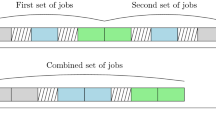Abstract
This paper focuses on an extension of the Economic Lot Scheduling Problem, which schedules productions of products on multiple identical machines. The objective is to minimize the total average production and inventory costs per unit time for all products. We develop a genetic algorithm under the Common Cycle policy and compare it with an existing heuristic under the same policy. Computational results show that our genetic algorithm outperforms the existing heuristic and its running time does not increase much even for high utilization problems, while the latter requires substantial time to solve most of the high utilization problems. In addition, a genetic algorithm under the Extended Basic Period and Power-of-Two policy is proposed. This new heuristic performs much better, especially when the number of machines is small and the machine utilization is not very high.
Similar content being viewed by others
References
Bomberger E (1966) A dynamic programming approach to a lot size scheduling problem. Manage Sci 12:778–784
Carreno JJ (1990) Economic lot scheduling for multiple products on parallel identical processors. Manage Sci 36:348–358
Chatfield D (2007) The economic lot scheduling problem: a pure genetic search approach. Comput Oper Res 34:2865–2881
Delaporte CM, Thomas LJ (1977) Lot size and sequencing for N products on one facility. Manage Sci 23:1070–1079
Dobson G (1987) The economic lot scheduling problem: achieving feasibility using time-varying lot sizes. Oper Res 35:764–771
Elmaghraby SE (1978) The economic lot scheduling problem (ELSP): review and extensions. Manage Sci 24:587–598
Garey MR, Johnson DS (1977) Computers and intractability: a guide to the theory of NP-completeness (see problem [SR1], page 226). W. H. Freeman, New York
Hanssman F (1962) Operations research in production and inventory. Wiley, New York
Haessler R (1979) An improved extended basic period procedure for solving the economic lot scheduling problem. AIIE Trans 11:336–340
Lopez MN, Kingsman BG (1991) The economic lot scheduling problem: theory and practice. Int J Prod Econ 23:147–164
Maxwell WL, Singh H (1986) Scheduling cyclic production on several identical machines. Oper Res 34:460–463
Zipkin P (1991) Computing optimal lot sizes in the economic lot scheduling problem. Oper Res 39:56–63
Author information
Authors and Affiliations
Corresponding author
Rights and permissions
About this article
Cite this article
Sun, H., Huang, HC. & Jaruphongsa, W. Genetic algorithms for the multiple-machine economic lot scheduling problem. Int J Adv Manuf Technol 43, 1251–1260 (2009). https://doi.org/10.1007/s00170-008-1808-7
Received:
Accepted:
Published:
Issue Date:
DOI: https://doi.org/10.1007/s00170-008-1808-7




